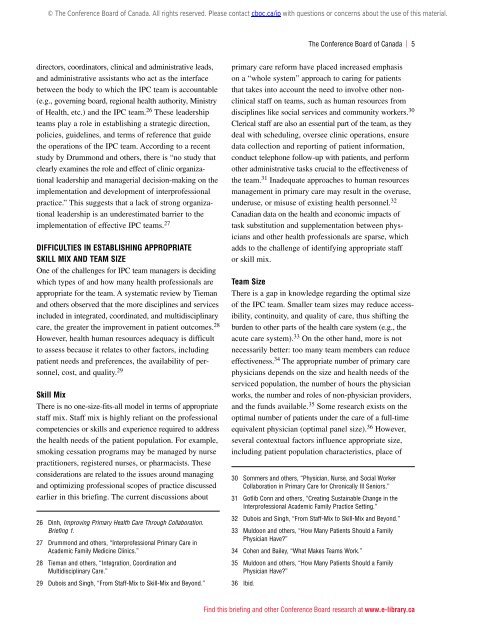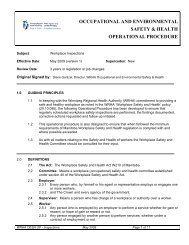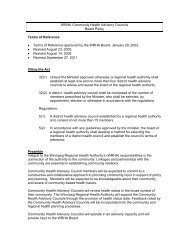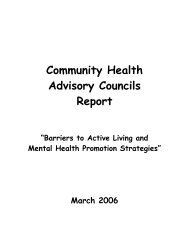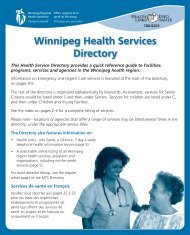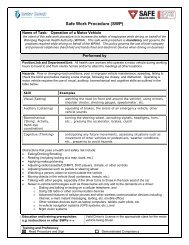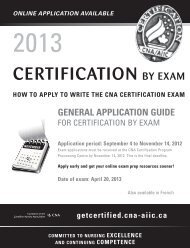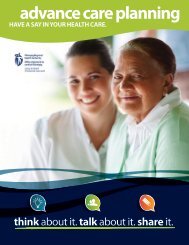Improving Primary Health Care Through Collaboration: Briefing 2 ...
Improving Primary Health Care Through Collaboration: Briefing 2 ...
Improving Primary Health Care Through Collaboration: Briefing 2 ...
- No tags were found...
You also want an ePaper? Increase the reach of your titles
YUMPU automatically turns print PDFs into web optimized ePapers that Google loves.
© The Conference Board of Canada. All rights reserved. Please contact cboc.ca/ip with questions or concerns about the use of this material.The Conference Board of Canada | 5directors, coordinators, clinical and administrative leads,and administrative assistants who act as the interfacebetween the body to which the IPC team is accountable(e.g., governing board, regional health authority, Ministryof <strong>Health</strong>, etc.) and the IPC team. 26 These leadershipteams play a role in establishing a strategic direction,policies, guidelines, and terms of reference that guidethe operations of the IPC team. According to a recentstudy by Drummond and others, there is “no study thatclearly examines the role and effect of clinic organizationalleadership and managerial decision-making on theimplementation and development of interprofessionalpractice.” This suggests that a lack of strong organizationalleadership is an underestimated barrier to theimplementation of effective IPC teams. 27Difficulties in Establishing AppropriateSkill Mix and Team SizeOne of the challenges for IPC team managers is decidingwhich types of and how many health professionals areappropriate for the team. A systematic review by Tiemanand others observed that the more disciplines and servicesincluded in integrated, coordinated, and multidisciplinarycare, the greater the improvement in patient outcomes. 28However, health human resources adequacy is difficultto assess because it relates to other factors, includingpatient needs and preferences, the availability of personnel,cost, and quality. 29Skill MixThere is no one-size-fits-all model in terms of appropriatestaff mix. Staff mix is highly reliant on the professionalcompetencies or skills and experience required to addressthe health needs of the patient population. For example,smoking cessation programs may be managed by nursepractitioners, registered nurses, or pharmacists. Theseconsiderations are related to the issues around managingand optimizing professional scopes of practice discussedearlier in this briefing. The current discussions about26 Dinh, <strong>Improving</strong> <strong>Primary</strong> <strong>Health</strong> <strong>Care</strong> <strong>Through</strong> <strong>Collaboration</strong>.<strong>Briefing</strong> 1.27 Drummond and others, “Interprofessional <strong>Primary</strong> <strong>Care</strong> inAcademic Family Medicine Clinics.”28 Tieman and others, “Integration, Coordination andMultidisciplinary <strong>Care</strong>.”29 Dubois and Singh, “From Staff-Mix to Skill-Mix and Beyond.”primary care reform have placed increased emphasison a “whole system” approach to caring for patientsthat takes into account the need to involve other nonclinicalstaff on teams, such as human resources fromdisciplines like social services and community workers. 30Clerical staff are also an essential part of the team, as theydeal with scheduling, oversee clinic operations, ensuredata collection and reporting of patient information,conduct telephone follow-up with patients, and performother administrative tasks crucial to the effectiveness ofthe team. 31 Inadequate approaches to human resourcesmanagement in primary care may result in the overuse,underuse, or misuse of existing health personnel. 32Canadian data on the health and economic impacts oftask substitution and supplementation between physiciansand other health professionals are sparse, whichadds to the challenge of identifying appropriate staffor skill mix.Team SizeThere is a gap in knowledge regarding the optimal sizeof the IPC team. Smaller team sizes may reduce accessibility,continuity, and quality of care, thus shifting theburden to other parts of the health care system (e.g., theacute care system). 33 On the other hand, more is notnecessarily better: too many team members can reduceeffectiveness. 34 The appropriate number of primary carephysicians depends on the size and health needs of theserviced population, the number of hours the physicianworks, the number and roles of non-physician providers,and the funds available. 35 Some research exists on theoptimal number of patients under the care of a full-timeequivalent physician (optimal panel size). 36 However,several contextual factors influence appropriate size,including patient population characteristics, place of30 Sommers and others, “Physician, Nurse, and Social Worker<strong>Collaboration</strong> in <strong>Primary</strong> <strong>Care</strong> for Chronically Ill Seniors.”31 Gotlib Conn and others, “Creating Sustainable Change in theInterprofessional Academic Family Practice Setting.”32 Dubois and Singh, “From Staff-Mix to Skill-Mix and Beyond.”33 Muldoon and others, “How Many Patients Should a FamilyPhysician Have?”34 Cohen and Bailey, “What Makes Teams Work.”35 Muldoon and others, “How Many Patients Should a FamilyPhysician Have?”36 Ibid.Find this briefing and other Conference Board research at www.e-library.ca


